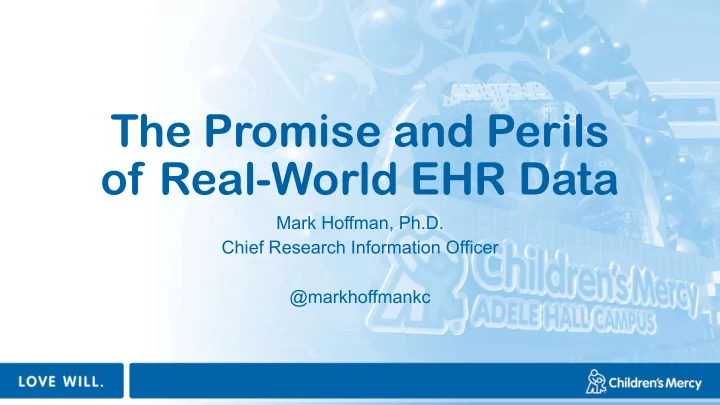

The Promise and Perils of Real-World EHR Data Mark Hoffman, Ph.D. Chief Research Information Officer @markhoffmankc
Children’s Research Institute • Kansas City, MO • Tower opens late 2020 • 9 floors + auditorium • Dry lab floor – data science, outcomes research, biostats
The gap between practice and policy What we apply in clinical practice • Training • Decision support Opportunity to improve • Clarify policy • Incentives Total Clinical • Individual variation • Organizational variation Knowledge What we know • Training gap but don’t apply • Absence of guideline • Resistance to guideline
Real world data – garden and jungle analogy Public health: Data garden EHR: Data jungle
Public Health – The Garden • Data capture instruments are designed by experts • Weeds are pruned out • Data is “validated” • Labor intensive • With few exceptions, small size
NHANES – A very lovely garden • National Health and Nutrition Examination Survey (NHANES) • CDC managed • Approximately 5000 people surveyed every year • Socioeconomic • Demographic • Health • Some lab tests
NHANES Survey Topics
Healthcare – The Jungle • Limited standardization • Limited “data validation” • Wide variation locally and regionally • Far more coverage • Many hazards
Cerner Health Facts – “Real world” data
Cerner Health Facts • 100 non-affiliated U.S. health • Data captured passively systems through delivery of patient care – VERY “real world” • 664 facilities • Minimize impact of • 69M patients participation among data • 23.4M encounters contributors – no requirement to change documentation or • 4.7B lab results processes • 728M inpatient medication orders • 6.8B Clinical events • Vitals, pain scores etc.
The promise of “real world data” Cinchona calisaya – Quinine
Opioid and migraine • Real world processes • Opioids are not recommended for migraines and can contribute to worsening of symptoms • Exposure to opioids increases risk of dependence • 180 US Emergency Departments in Health Facts • We found that 23% of youth and young adults presenting with migraine are given an opioid • Facility level variation • Specialty variation (sorry surgeons) Connelly, M; Glynn, EF; Hoffman, MA, Bickel, J “Rates and predictors of using opioids in the Emergency Department to treat migraine in adolescents and young adults” Ped. Emerg. Care, Jun 22, 2019 PMID: 31246788
Factors associated with opioid ordering • Provider: • Surgeon • Smaller facility • Patient: • White • Female
Obesity class and drug-dosing 95% CI OR Lower Upper 0.879 0.768 1.005 1.202 1.093 1.323 1.246 1.134 1.37 1.351 1.178 1.55 1.629 1.368 1.939 • Kate Kyler, MD – MS thesis in Biomedical and Health Informatics • Adherence to asthma drug dosing for steroids
Navigate hazards – Data profiling • Real world data is messy • Need to understand gaps and inconsistencies in the data • Need to understand known causes of “missing data”
Scenario 1 • Laboratory test utilization analysis • Notice that patients with condition from 151 facilities do not have A1c test •Why??
EHR modules • EHR systems are not uniformly implemented • Modularity • 159 using all modules except surgery • 88 facilities not using ancillary modules • 49 using all modules Glynn, EF; Hoffman, MA “Heterogeneity introduced by EHR system implementation in a de-identified data resource from 100 non-affiliated organizations” JAMIA Open (accepted)
Scenario 2 • Examine trend in smoking based on EHR prompt •Why??
Understand policy environment of data • Meaningful Use required documentation of smoking status • At the health system level, some organizations initially used prompt and then discontinued Glynn, EF; Hoffman, MA “Heterogeneity introduced by EHR system implementation in a de-identified data resource from 100 non-affiliated organizations” JAMIA Open 2019
ICD-9 to 10 transition Glynn, EF; Hoffman, MA “Heterogeneity introduced by EHR system implementation in a de-identified data resource from 100 non-affiliated organizations” JAMIA Open (accepted)
Understand data process 2 Health Systems 100 Health Systems Facility level variation within health systems Glynn, EF; Hoffman, MA “Heterogeneity introduced by EHR system implementation in a de-identified data resource from 100 non-affiliated organizations” JAMIA Open (accepted)
Variation in documentation Use of discharge disposition to document death Facility bed size Number of Facilities Facilities Not % Reporting (range) Facilities Reporting Reporting Deaths Deaths Deaths 1-5 294 67 227 22.8% 6-99 154 141 13 91.6% 100-199 80 72 8 90.0% 200-299 63 48 15 76.2% 300-499 43 36 7 83.7% 500+ 28 19 9 67.9% Unknown 2 1 1 50.0% ALL FACILITIES 664 384 280 57.8% Glynn, EF; Hoffman, MA “Heterogeneity introduced by EHR system implementation in a de-identified data resource from 100 non-affiliated organizations” JAMIA Open (accepted)
This should be easy… What we want to imagine: a well oiled The reality… there is often a “[person] data machine behind the curtain”
Recommendations Source of variation Recommendation Variation in ancillary Evaluate facility level use of topic specific data tables and fields. module adoption Temporal variation of Evaluate contribution of each organization over time. Structure analyses contributors to exclude organizations when they were not actively contributing data. ICD version For analyses that span the transition period from ICD-9 to ICD-10, estimate when data contributing organizations shifted from ICD-9 to ICD- 10. Outcome measure For each organization, evaluate the availability of key outcomes measures. Exclude organizations that are not documenting the measure in the expected manner. Do not assume continuous, consistent usage . Variation in Confirm that each organization in an analysis is using the documentation documentation prompt(s) needed for an analysis, exclude those that do not. Evaluate conceptual overlaps in the descriptions of variations for similar concepts. Evaluate whether usage of prompt(s) is consistent over time.
Thank you! Collaborators: • Jennifer Bickel, MD • Mark Connelly, Ph.D. • Mark Hoffman, Ph.D. • Kamani Lankachandra, MD • mhoffman@cmh.edu • An-Lin Cheng, Ph.D. • Kate Kyler, MD • @markhoffmankc • Suman Sahil Thanks to my team!
Recommend
More recommend